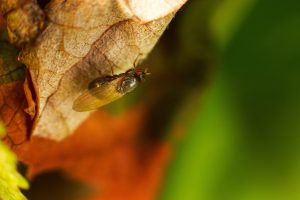
Understanding how animals—from insects to humans—control behavior such as walking, running, and flying is one of the great challenges in neuroscience.
Noah Cowan, a professor of mechanical engineering and director of Johns Hopkins Locomotion in Mechanical and Biological Systems (LIMBS) Laboratory, investigates how the brain and body of animals work to achieve agile and intentional movement. His objective? To inform the design of better prosthetic devices and robots that can assist people in a variety of tasks, from physical rehabilitation to performing search-and-rescue in extreme situations, such as fire or earthquake.
Recently, Cowan worked with a team of researchers at Cornell University to try to figure out how Drosophila, the humble fruit fly, controls its movements so precisely and elegantly. The team’s results appeared in Science Advances.
We sat down with Cowan to talk about this recent study.
What problem were you trying to solve or what question were you trying to answer?
A lowly fruit fly is capable of amazing precision and agility. How does it do it? One of the keys to their success is control: how they balance themselves during flight. In this study, we sought to understand how a fly uses its neuromuscular system to control its movements, while making sometimes millisecond adjustments. We hypothesized that, instead of the smarts of the controller residing in the flies’ brains, that it was the insects’ muscles that might be doing some of the computation. This study aimed to understand how the controller was implemented by muscles.
How did you go about solving it or answering that question?
I worked with a team of biologists and physicists that used modern genetic engineering and sophisticated experiments to trip up a fly during flight, and measure how the fly corrected itself after being tripped in midair. One of the team’s amazing ideas was to use genetic manipulations to turn individual muscles on and off during these arial stumbles to figure out their role during flight control.
What were the results? What did you learn?
Quite amazingly, different individual “terms” in the flies controller are, more or less, computed by different, individual muscles. To break this down a little further, the flies implement something called a “PID” controller, where P stands for “Proportional” and I stands for “Integral” and D stands for “Derivative”. If you Google “PID Controller,” you’ll see thousands of hits—YouTube videos, tutorials, and many commercial products. What we found is that flies implement a simplified version of this (a PI controller), and that one muscle implements the P term, and another implements the I term; literally, the computation that you find in textbooks is split up into different muscles in the fly. To me, this is a stunning connection between engineering and evolution.
Why is what you learned important? Are there potential or immediate real-life applications?
It is true that AI continues to amaze us with its incredible art, its amazing ability to produce clear text, enable voice recognition, and more. Despite these advances, AI has yet to produce robots that exhibit even a small fraction of the agility as even a common house fly! This study takes us one more step toward understanding the amazing, intricate details of animal movement and its control, toward our journey in a synthetic motion science.
Now what? What are the next steps in this research?
There is still so much we don’t understand about how animals control their sensing and action. In the LIMBS lab, we’re working with half a dozen neuroscientists at Hopkins and all around the US to try to bring a control engineering perspective to understanding animal sensing, navigation, and control. Understanding movement in animals, and translating it to robotic systems, will require many sets of discoveries in a wide range of animal systems—each one helping us make small advances and, when we are lucky, big leaps.